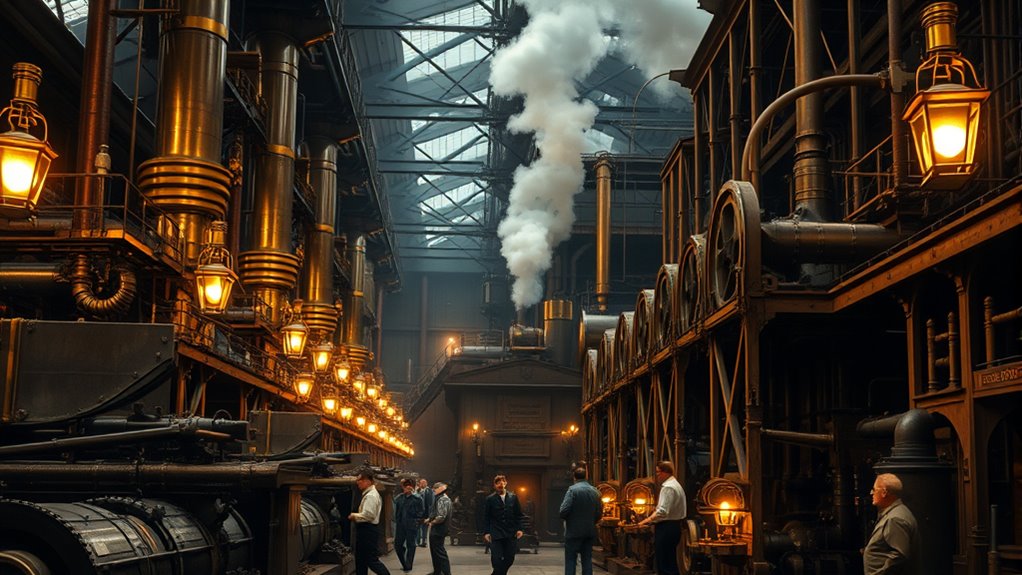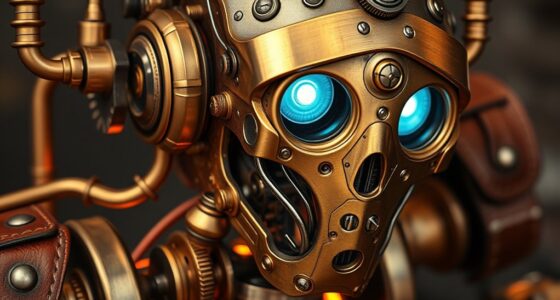Victorian factory machines powered by steam transformed industry by boosting production speed and efficiency, leading to larger factories and more goods. These innovations changed how people worked, often with long hours and dangerous conditions. Workers faced safety risks and low wages, prompting the rise of labor movements. By harnessing steam power, industries grew rapidly, making products more affordable. If you want to understand how these advancements shaped society and labor, there’s much more to explore.
Key Takeaways
- Steam engines powered large factory machines, revolutionizing manufacturing speed and efficiency during the Victorian era.
- Mechanization led to increased production capacity, enabling mass goods supply for domestic and international markets.
- Factory machines replaced manual labor, requiring new skills and transforming the workforce environment.
- The rise of steam-powered machinery contributed to social challenges, including worker safety issues and labor unrest.
- Technological innovation in steam power drove industrial growth but also prompted calls for labor reforms and improved worker conditions.

During the Victorian era, factory machines revolutionized manufacturing by dramatically increasing production speed and efficiency. These innovations transformed industries, enabling goods to be produced faster than ever before. But while the machines boosted productivity, they also brought about significant social challenges. As factories grew larger and more complex, workers faced long hours, dangerous conditions, and low wages. This led to a rising demand for labor reform, prompting activists and reformers to push for better working conditions, fair wages, and limits on working hours. You might have seen how these efforts aimed to balance technological progress with workers’ rights, shaping the labor landscape of the time.
The core driver behind this industrial transformation was technological innovation. Steam power, in particular, became the backbone of Victorian factory machinery. With steam engines fueling machines like spinning jennies and power looms, production didn’t just increase; it skyrocketed. These machines allowed factories to operate on a scale previously unimaginable, reducing reliance on manual labor and traditional handcrafting. As a result, factories could produce textiles, iron goods, and other products at a rapid pace, satisfying growing markets both domestically and abroad. The shift from handcraft to mechanized manufacturing marked a pivotal moment in history, making goods more affordable and accessible to the masses.
You can imagine how these advancements changed the everyday life of workers and factory owners. Factory owners saw profits soar as the machines worked tirelessly, but workers struggled to keep up with the relentless pace. The introduction of complex machinery meant workers needed new skills, yet many were untrained or under-trained, which sometimes led to accidents and injuries. This situation fueled ongoing discussions about labor reform, as workers demanded safer conditions and fair treatment. The rise of labor unions and protests highlighted the importance of balancing technological innovation with social responsibility. It was a time when progress was not just measured by machines but also by how society adapted to and regulated these new industrial realities.
Frequently Asked Questions
How Did Factory Machines Impact Workers’ Daily Lives?
Factory machines changed your daily life by transforming factory work conditions, making tasks faster but often more exhausting. You faced long hours, loud noises, and cramped spaces, which affected your health and safety. Injuries were common because safety measures were limited. Despite increased productivity, your work environment became more hazardous, impacting your well-being. You had to adapt to the relentless pace and risks that came with working alongside powerful steam-powered machines.
Were Victorian Factory Machines Safe for Operators?
Victorian factory machines weren’t very safe for operators. Safety regulations were minimal, and operators often lacked proper training, increasing the risk of accidents. You might have worked around dangerous machinery without adequate safety gear or procedures, making injuries common. Factory owners prioritized productivity over safety, so it’s likely you faced hazards daily. Proper safety measures and training only became standard later, after many injuries and fatalities highlighted the need for change.
How Did Factory Machines Influence Global Trade?
Factory machines greatly influenced global trade by boosting textile innovation and enabling faster, mass production. You’d notice that with these advancements, goods became cheaper and easier to export, expanding trade networks worldwide. This increased efficiency meant countries could trade more textiles and manufactured goods, strengthening economies and connecting markets. As a result, factory machines transformed global trade, making it more dynamic and accessible, shaping the modern interconnected world you see today.
What Materials Were Commonly Used in Machine Construction?
You’ll find that machine construction mainly used metal alloys like iron and steel for durability and strength. Wooden components were also common for parts that didn’t need to withstand extreme stress, such as frames or handles. This combination allowed machines to operate efficiently and withstand heavy use. The use of metal alloys provided the necessary resilience, while wooden parts helped reduce costs and made assembly easier.
How Did Technological Innovations Evolve During the Victorian Era?
They say, “Necessity is the mother of invention,” and during the Victorian era, technological innovations evolved rapidly. You see this in textile innovation, which revolutionized cloth production, and steam engine development, powering factories and transportation. These advancements spurred industrial growth, making processes faster and more efficient. You’re witnessing a time where continued innovation propelled society forward, transforming everyday life and work environments in ways previously unimaginable.
Conclusion
As you step back and reflect on these machines, remember they’re more than just iron and steam—they symbolize progress and ambition. These mighty engines, like the heartbeat of the Victorian era, drive us forward, pushing boundaries and shaping futures. Just as gears turn in harmony, so too must we embrace change with determination. Let these machines remind you that innovation fuels growth, and every chime of progress echoes with the promise of a brighter tomorrow.









